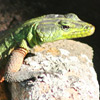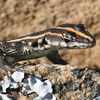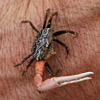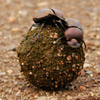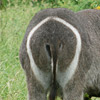Horns on male and female. Male marks his territory with a dung heap. Young born in December.
Fieldguide
Name: Bontebok
Classification: Mammal
Place first seen: Bontebok National Park, Cape, South Africa
Date spotted: January 2012
Description:
Name: Lizard, Common flat
Classification: Reptile
Place first seen: Great Zimbabwe Ruins, Zimbabwe
Date spotted: February 2012
Description:
A beautiful creature, very colourful. It looked a bit like a dragon that had lost its wings.
Name: Skink, striped
Classification: Reptile
Place first seen: Great Zimbabwe Ruins, Zimbabwe
Date spotted: February 2012
Description:
The lizard was in the King’s Enclosure, we watched it climb a high horizontal rock wall.
Name: Crab, Mud
Classification: Crustacean
Place first seen: Barra, Mozambique
Date spotted: January 2012
Description:
Hid under the Landrover.
Name: Crab, Asymmetric
Classification: Crustacean
Place first seen: Barra, Mozambique
Date spotted: January 2012
Description:
One huge claw. These are the first really asymmetric animals we have ever seen. They were on the beach.
Name: Francolin, Grey Winged
Classification: Bird
Place first seen: Bontebok National Park, Cape, South Africa
Date spotted: January 2012
Description:
Often found in bushes beside roads, very timid. The black spots on the throat distinguish it from other francolins.
Name: Crab, Fiddler
Classification: Crustacean
Place first seen: Barra, Inhambane, Mozambique
Date spotted: January 2012
Description:
We saw thousands of them in the Pomene mangroves. One claw is much bigger than the other – useful for fiddling!
Name: Bee, Carpenter
Classification: Insect
Place first seen: Abbotsleigh Rd. swimming pool, Cape Town, South Africa
Date spotted: January 2012
Description:
Rescued from grandparents’ swimming pool
Name: Beetle, Dung
Classification: Insect
Place first seen: Kruger National Park, South Africa
Date spotted: January 2012
Description:
Dung Beetles lay their eggs in dung. They roll the dung along the ground. They then bury the dung ball. When the larvae hatch, they eat the dung as nutrition for a few weeks.

